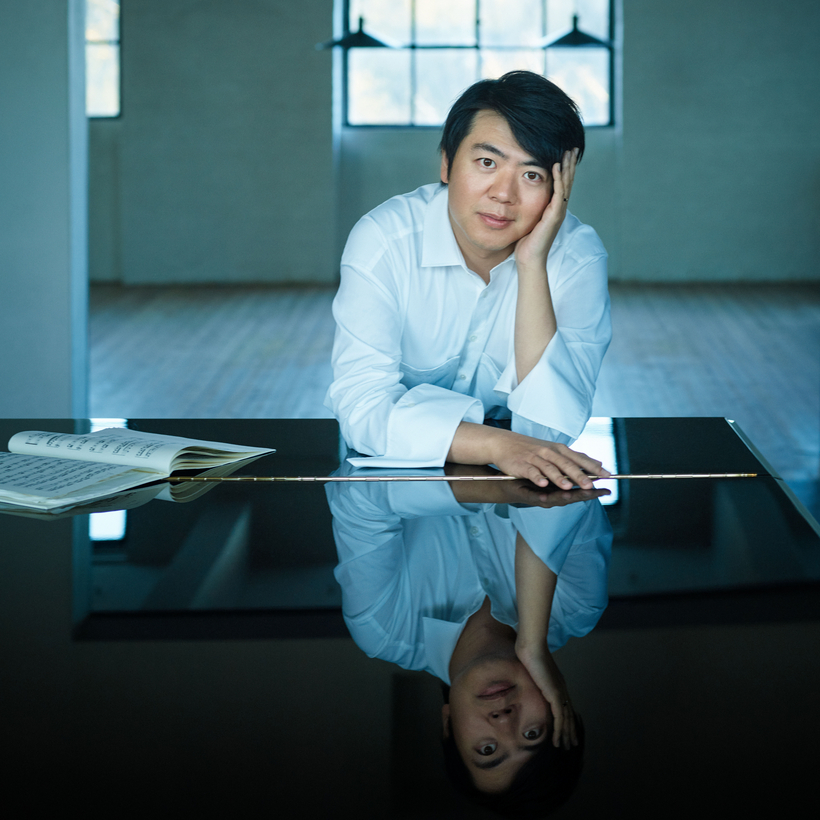Going on 40 years after his death, the Canadian rock star of classical music turned phantom of the recording studio, Glenn Gould, occupies an unshakable niche in the pantheon. Of the work that put him there and keeps him there, nothing looms larger than a pair of Bach recordings that Sony Classical reissued back-to-back at the dawn of the 21st century—Glenn Gould: A State of Wonder / The Complete Goldberg Variations 1955 & 1981.
“I love the Glenn Gould recordings!,” Lang Lang exclaimed on Zoom from Shanghai last week, anticipating the September 4 release of a Goldberg two-pack of his own on Deutsche Grammophon. “Both of them. What I like about the earlier version is that he was fearless. Some passages are so fast! There’s a real passion behind those notes. Later, I would say, he played with much deeper thoughts, really taking time. Huge difference.”
And a huge difference between Gould’s historic interpretations and Lang Lang’s new ones is that the new ones run roughly twice as long, because Lang Lang takes all of Bach’s repeats and Gould did not. Lang Lang’s twin readings—one from the studio, one live—clock in at about 90 minutes each, against Gould’s 38 in 1955 (when he took no repeats) and 51 in 1981 (when he took 12 strategically placed repeats out of a possible 64).

What to repeat, if anything? This is but one of the fundamentals aficionados fight about. Here’s another. For the keyboard masterpieces, what sort of instrument is best? A period harpsichord with parallel upper and lower keyboards, as Bach specified? Or a modern concert grand, with its hugely expanded dynamic range, its broader palette, and the acoustics-altering sustaining pedal, the so-called soul of the piano? The magisterial Daniel Barenboim has framed a Solomonic answer in the conditional mode: “If one wishes to play Bach on the piano,” he once wrote, “the piano must be used like an orchestra.”
Goldberg, Through the Ages
The first to record the Goldberg Variations was the doughty Polish harpsichordist Wanda Landowska, in 1933. Nine years later, Claudio Arrau, of Chile, followed with the first recording on a modern piano. Yet it was Gould who pinned the opening aria and the ensuing dazzlement of 30 dances, canons, and inventions in the constellation of cosmopolitan consciousness. There it blazes among the Winged Victory, the Grand Canyon, and the Great Wall of China.
Lang Lang’s studio recording of the Goldberg Variations is the product of four pressured days in Berlin. The other documents a live concert at the Thomaskirche, in Leipzig, the very shrine where Bach served as Kapellmeister from 1723 to 1750. A tomb bearing the name Johann Sebastian Bach inscribed in bronze has a place of honor in the sanctuary, though the authenticity of the enclosed remains is in dispute. Lang Lang’s Leipzig performance was one of just three before March 11, when an extended tour was cut short by the pandemic.
Lang Lang’s studio recording of the Goldberg Variations is the product of four pressured days in Berlin.
A classical rock star if ever there was one, Lang Lang was born in the boondocks of Shenyang, on June 14, 1982, four months before Gould’s death, and gave his first public recital at the age of five. A self-styled “popularizer,” he has always been the most accessible of virtuosos, whizzing through showpieces with flair and a smile, delivering fireworks in the highest of high definition. No one denies the excitement, even critics who have hammered him as flashy, superficial, vulgar, and cold. Less judgmentally, one might suggest that, in his hands, bold sensory impressions have typically taken priority over intellectual finesse.

To date, Bach has rated scarcely a footnote in the Lang Lang discography. Yet the mandarin Goldberg Variations have been on his mind for decades; at 17, he had the gumption to play the whole shebang, by heart, at an impromptu post-concert midnight musicale for an intimate audience of superstars including Midori and Yo-Yo Ma. Going public now, he invites the world to consider his art in a new light. Excerpts from our conversation follow.
Matthew Gurewitsch: Glenn Gould’s two Goldberg recordings were made a quarter-century apart. Yours are practically simultaneous. Why did you decide to release them together?
Lang Lang: We didn’t plan to release the live recording in the beginning. We were shooting in the church just for a documentary, with a very long studio recording set for two weeks after. But I thought it would be good to hear the live recording to see if there was something to inspire me for the studio recording. And I found it very spontaneous, right in the moment. I wasn’t thinking too much. The connection between variations felt very convincing. And I thought it would be pretty nice to have that, most importantly because it was done in Bach’s church. Playing next to Bach’s grave gave me mysterious inspiration, which I don’t think we have in the studio. Thank God we had the few live performances we did! Without those, I wouldn’t have made a recording at all.
M.G.: Gould famously gave up live concerts in 1964 and spent the remaining years of his life as a recording artist exclusively, fiddling endlessly over his edits. And this was in the era of tape, when the splices had to be made by hand.
L.L.: Yes, Gould said he believed the studio recording would be the one to remember. At the same time, I know two very good live recordings of the Goldberg Variations from the late 1980s: Daniel Barenboim’s from the Teatro Colón, in Buenos Aires, and one by Grigory Sokolov, who barely ever recorded in the studio. So, I realized: there’s no real rule whether live is better or the studio is better. When I was a kid, I much preferred to record live. The red light in the studio made me nervous. I told the producer, I’ll just play. Don’t put on the red light! Strategy! Red light! That means something’s forbidden. There’s an invisible wall that kept me away from real emotion. A little Iron Curtain.
M.G.: And I’m guessing a lot of distraction?
L.L.: A lot of playing and listening and playback. It’s very unlike live recording. With the live version, I did a run-through and the concert. No patch session. I was too tired! In the studio, I took some naps, had some snacks, some coffee. There were lots more spaces.
“Playing next to Bach’s grave gave me mysterious inspiration, which I don’t think we have in the studio.”
M.G.: Gould complained of the “non-take-two-ness” of a live performance, which is to say the impossibility of correcting outright mistakes, or even fine nuances. I think you like non-take-two-ness.
L.L.: Yes! I do!
M.G.: Each part of the Goldberg Variations is in two sections, and each section is marked for repeats. Many interpreters ignore the repeats, but you take them all. What’s your thinking there?
L.L.: Taking a repeat is almost like having a second life. The second life is more improvised, with ornamentation, the way jazz musicians like to improvise.
M.G.: Privately, you’ve been living with Bach for ages. Why was this the moment for you to get serious about playing Bach in public?

L.L.: I wasn’t ready before. There was lots I had to find out in terms of style. The first time I played the Goldberg Variations, for Maestro Nikolaus Harnoncourt in Salzburg in 2006, he totally opened my way of thinking about Baroque. So often we’re told to play Bach clean, to use no pedal, to make no big dramatic contrast, to have less color. You think about what you’re not supposed to do. You’re afraid of breaking the rules. Harnoncourt made me realize Bach is also very passionate, very passionate, in certain ways we have to learn first. So, I went to Andreas Staier, who is a brilliant musician and teacher who comes from an older world. In the beginning, I was trying to play lively, be more interesting. And Staier said, “Why do you think you’re doing a lot of interesting things? They’re very boring. The tricks are obvious! You have to think this is like a big game. Go in slowly, don’t do everything in the first three variations.” You have to strategize.
M.G.: Many years ago, you said in an interview that, in Beijing, you were taught very well in terms of your fingers, but not so much in terms of style or cultural context. It sounds like you’ve never stopped being hungry for that.
L.L.: I love reading. And when I came to study in America, I started learning about Shakespeare. I read Hamlet, Romeo and Juliet, Julius Caesar, Macbeth, King Lear. That was very important, learning to understand a great character in a great play. In music, too, you have to feel the character, no matter what the piece is. You’re telling stories through your fingers.
M.G.: You made your name with technique. More recently, it seems that you want to bring out a deeper or just a more personal message, which may not require big technique at all. One of your recent albums, Piano Book, consists entirely of pieces lots of beginners play.
L.L.: It’s true, I’m more interested in the message. It’s part of the ongoing process of becoming a better musician. Technique should be only a tool. I want to take the opportunity to improve myself mentally. Another Chopin or Rachmaninoff at 38 will not challenge my mind; it will only challenge my fingers. No matter what kind of musician you are, you have to be curious about the next step, breakthrough, and find something you didn’t have before. The more you grow up, the more you should challenge yourself—or you’ll have a midlife crisis. Many virtuosos after their 30s become very quiet.
M.G.: Has the pandemic given you time to think about what’s next, new ways to expand your horizons?
L.L.: I’ve been practicing during the coronavirus period more Beethoven sonatas, Schubert sonatas, Chopin mazurkas. The mazurkas are not about technique! They’re about folk-Polish taste, which is very fascinating to me. Maybe going forward, I’ll do some Brahms that’s very difficult to play, or more Schumann. And I’m more confident about the Baroque now. Maybe I’ll play some Handel or Scarlatti. Or more Bach! But nothing like the Goldberg Variations! Nothing this long. This is the longest piece. It’s opened another dimension.
Matthew Gurewitsch writes about classical music and opera for AIR MAIL



 Discover
Discover